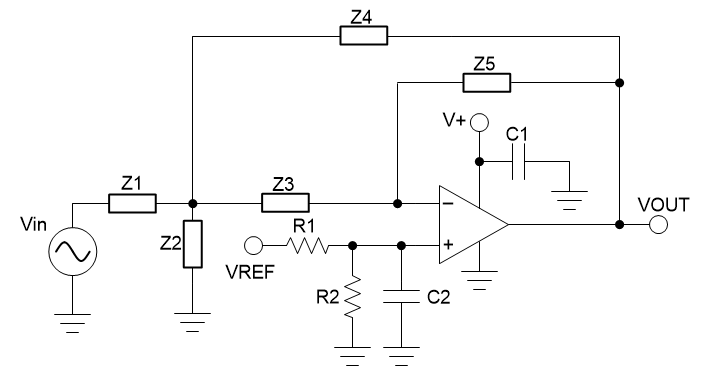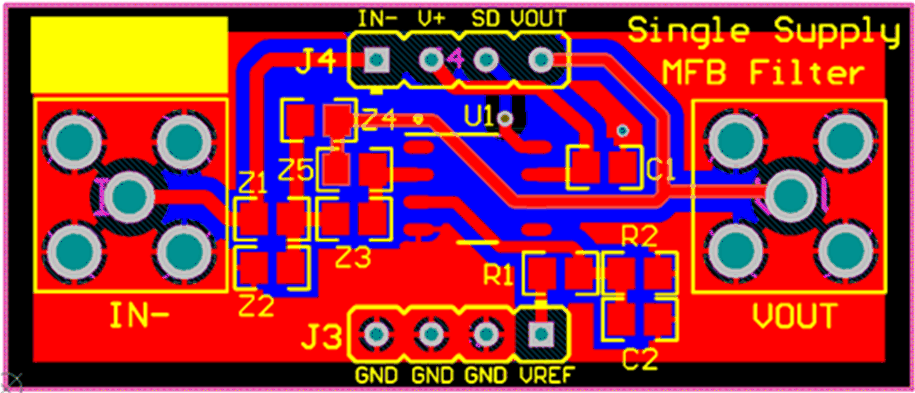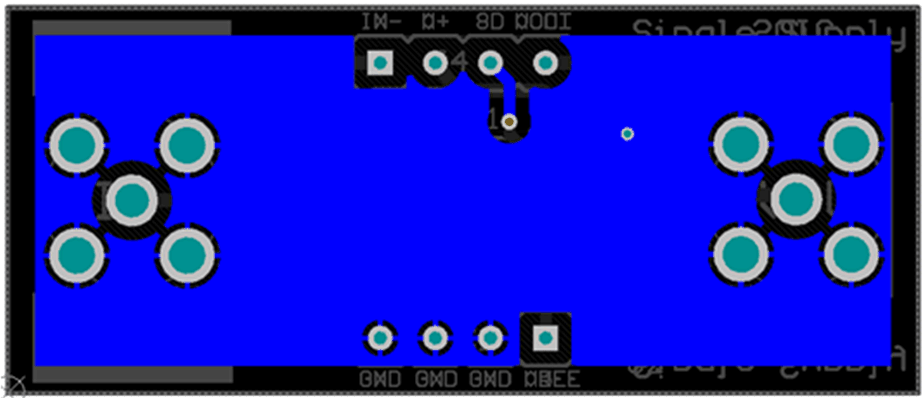SBOU162A March 2017 – May 2017
-
DIYAMP-SOIC-EVM
- Trademarks
- 1 Introduction
- 2 Hardware Setup
- 3
Schematic and PCB Layout
- 3.1 Schematic PCB Drawing
- 3.2 Single-Supply, Multiple Feedback Filter
- 3.3 Single-Supply, Sallen-Key Filter
- 3.4 Single-Supply, Non-Inverting Amplifier
- 3.5 Single-Supply, Inverting Amplifier
- 3.6 Difference Amplifier
- 3.7 Dual-Supply, Multiple Feedback Filter
- 3.8 Dual-Supply, Sallen-Key Filter
- 3.9 Inverting Comparator
- 3.10 Non-Inverting Comparator
- 3.11 Riso With Dual Feedback
- 3.12 Dual-Supply, Non-Inverting Amplifier
- 3.13 Dual-Supply, Inverting Amplifier
- 4 Connections
- 5 Bill of Materials and Reference
- Revision History
3.2 Single-Supply, Multiple Feedback Filter
Figure 9 shows the schematic for the single-supply, multiple feedback (MFB) filter circuit configuration.
 Figure 9. Single-Supply, Multiple Feedback Filter Schematic
Figure 9. Single-Supply, Multiple Feedback Filter Schematic The MFB topology (sometimes called infinite gain or Rauch) is often preferred, due to low sensitivity to component variations. The MFB topology creates an inverting second-order stage. This inversion may, or may not, be a concern in the filter application.
The single-supply, MFB filter circuit can be configured as a low-pass filter, high-pass filter, or band-pass filter based on the component selection of Z1 through Z5. Table 3 displays the type of passive component that should be chosen for Z1 through Z5 for each filter configuration.
Table 3. MFB Filter Type Component Selection
| Pass-Band
Filter Type |
Type of Component (Z1) | Type of Component (Z2) | Type of Component (Z3) | Type of Component (Z4) | Type of Component (Z5) |
|---|---|---|---|---|---|
| Low Pass | R1 | C2 | R3 | R4 | C5 |
| High Pass | C1 | R2 | C3 | C4 | R5 |
| Band Pass | R1 | R2 | C3 | C4 | R5 |
For additional guidance in designing a filter, download FilterPro™ active filter design software.
Capacitor C2 provides the option to filter noise that may be introduced from the Vref input. calculates the cutoff frequency due to C2.

The PCB layout of the top layer of the single-supply, MFB filter configuration is displayed in Figure 10.
 Figure 10. Single-Supply, MFB Filter Top Layer
Figure 10. Single-Supply, MFB Filter Top Layer The PCB layout of the bottom layer of the single-supply, MFB filter configuration is displayed in Figure 11.
 Figure 11. Single-Supply, MFB Filter Bottom Layer
Figure 11. Single-Supply, MFB Filter Bottom Layer